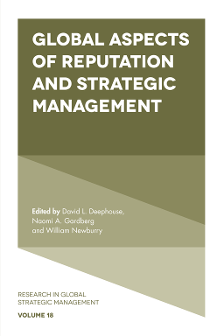
Index
Global Aspects of Reputation and Strategic Management
ISBN: 978-1-78754-314-0, eISBN: 978-1-78754-313-3
ISSN: 1064-4857
Publication date: 16 July 2019
Citation
(2019), "Index", Global Aspects of Reputation and Strategic Management (Research in Global Strategic Management, Vol. 18), Emerald Publishing Limited, Leeds, pp. 269-274. https://doi.org/10.1108/S1064-485720190000018015
Publisher
:Emerald Publishing Limited
Copyright © 2019 Emerald Publishing Limited
INDEX
- Prelims
- Global Aspects of Reputation and Strategic Management
- Section I Managing a Global Reputation
- Global Reputation Management: Understanding and Managing Reputation as Shared Value across Borders
- The Role of Values in the Creation and Maintenance of an Organization’s Reputation
- Global Value Chains, Reputation, and Social Cooperation
- Section II National Context and Reputation
- Does Country Really Matter? Exploring the Contextual Effect of Individual Self-construal in Reaping the Relational Benefits of Customer-based Reputation
- National Culture Characteristics for Managing Corporate Reputation and Brand Image Using Social Media
- Economic Indicators Affecting the Media Reputation of a Country: The Case of Chile (1990–2015)
- Section III The Nature of Reputation Measurement
- Praemia Virtutis Honores? The Making of Global Reputations and the False Promise of Meritocracy
- Why Do People Love Museums So Much? Empirical Evidence about the Stellar Reputations of Art Museums and What Companies Can Learn From It
- The Reputation of Companies across Different Countries: Some Keys to Validating the Comparison of Results
- Index